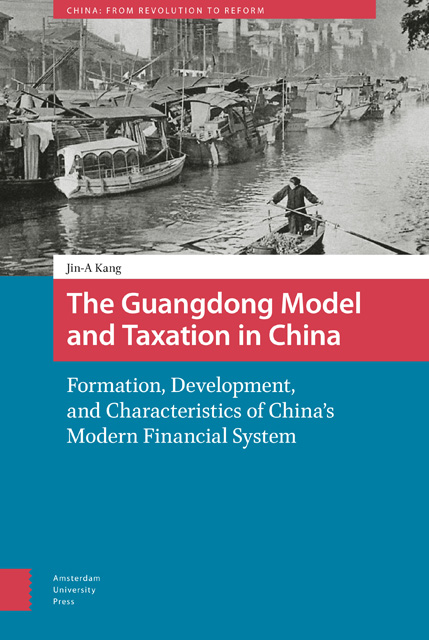 The Guangdong Model and Taxation in China
The Guangdong Model and Taxation in China Published online by Cambridge University Press: 10 January 2023
Abstract
Chapter 9 traces the long-term change in the Chinese fiscal structure compared to comparable counterparts and reference countries at each stage of development. Tax reform in contemporary China is examined as the interrupted but continuing efforts for fiscal modernization in China. It helps to identify the features of Chinse fiscal modernization and the impact of the Guangdong model. Tax structure in contemporary China is characterized by high dependence on the indirect tax and the significant fiscal weight of the corporate tax outplaying the individual income tax revenue. This reflects the legacy of Nationalist in socialist China. There is a continuing suspicious attitude toward profiteering private industries, and the goal is to support economic building driven by state-owned industries.
Keywords: China, Guangdong, direct tax, indirect tax, tax structure
The tax modernization pursued in modern and contemporary China did not proceed in a manner that was disconnected from the outside world. Rather, it was carried out with an awareness of and reference to trends in the tax systems in other countries. For example, the tax reforms of the late Qing empire and Republican China were profoundly influenced by the Japanese Meiji fiscal model. There is comparable example in the United States as the size of the country grew important during the Nationalist period. More recently, the People's Republic of China has been studying the United States as a reference model for future tax reforms.
A. K. Mehrotra, an American historian of legal history and tax law, suggests that historical research on taxation is an area that can shed new light on the history of capitalism. Modern countries feature a legitimate monopoly over violence, such as the military and the police as well as legal and exclusive rights to collect taxes. They have also developed their own tax systems in line with their economic structures and stage of industrialization. The trajectory of tax policy varies in line with the various paths of capitalist development.
This chapter investigates long-term change in the Chinese fiscal structure in comparison with comparable counterparts and reference countries at each stage of development, with the aim of identifying the features of Chinese fiscal modernization and the impact of the Guangdong model.
To save this book to your Kindle, first ensure [email protected] is added to your Approved Personal Document E-mail List under your Personal Document Settings on the Manage Your Content and Devices page of your Amazon account. Then enter the ‘name’ part of your Kindle email address below. Find out more about saving to your Kindle.
Note you can select to save to either the @free.kindle.com or @kindle.com variations. ‘@free.kindle.com’ emails are free but can only be saved to your device when it is connected to wi-fi. ‘@kindle.com’ emails can be delivered even when you are not connected to wi-fi, but note that service fees apply.
Find out more about the Kindle Personal Document Service.
To save content items to your account, please confirm that you agree to abide by our usage policies. If this is the first time you use this feature, you will be asked to authorise Cambridge Core to connect with your account. Find out more about saving content to Dropbox.
To save content items to your account, please confirm that you agree to abide by our usage policies. If this is the first time you use this feature, you will be asked to authorise Cambridge Core to connect with your account. Find out more about saving content to Google Drive.